Hyundai Palisade: Lubrication System / Engine Oil
Repair procedures
| • |
Be careful not to damage the parts located under the vehicle
(floor under cover, fuel filter, fuel tank and canister) when
raising the vehicle using the lift.
(Refer to General Information - "Lift and Support Points")
|
|
| • |
Prolonged and repeated contact with mineral oil will result
in the removal of natural fats from the skin, leading to dryness,
irritation and dermatitis. In addition, used engine oil contains
potentially harmful contaminants which may cause skin cancer.
|
| • |
Exercise caution in order to minimize the length and frequency
of contact of your skin to used oil. Wear protective clothing
and gloves. Wash your skin thoroughly with soap and water, or
use water-less hand cleaner, to remove any used engine oil.
Do not use gasoline, thinners, or solvents.
|
| • |
In order to preserve the environment, used oil and used oil
filter must be disposed of only at designated disposal sites.
|
|
| 1. |
Park the car on level ground.
|
| 2. |
Drain engine oil.
| (1) |
Remove the oil filler cap.
|
| (2) |
Remove the drain under cover (A).
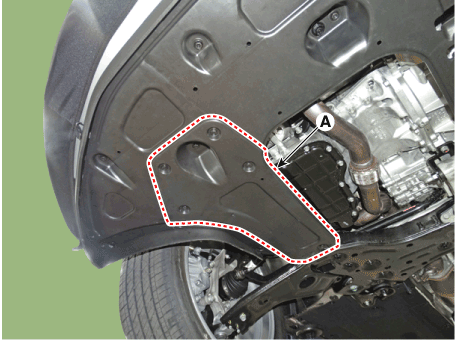
|
| (3) |
After lifting the car, remove the oil drain plug (A) and drain
oil into a container.
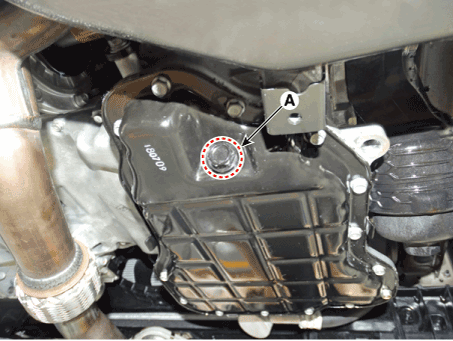
|
|
| 3. |
Replace the oil filter.
| (1) |
Remove the oil filter cap (A).
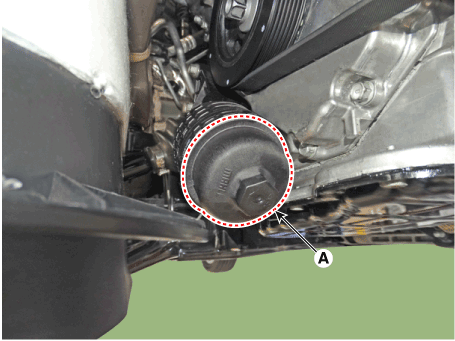
|
| (2) |
Replace the O-ring (A) of oil filter cap with a new one.
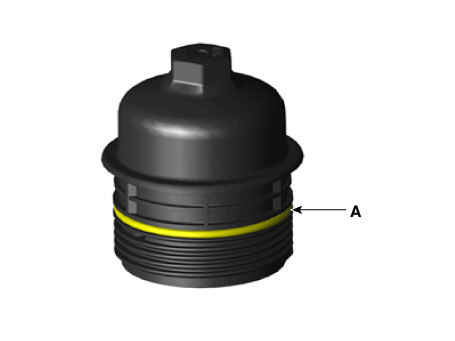
|
| (3) |
Replace the new oil filter element (A).
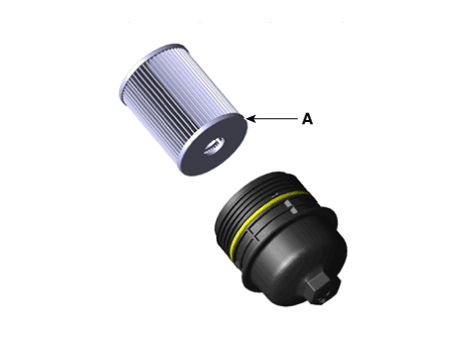
|
| (4) |
Check and clean the oil filter installation surface.
|
| (5) |
Apply clean engine oil to the new O-rings (A).
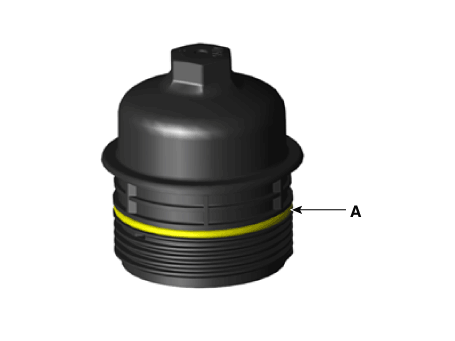
|
| (6) |
Lightly screw the oil filter cap into place, and tighten it
until the O-ring contacts the seat.
|
• |
Check if the o-ring (A) is installed correctly
inside the cap.
|
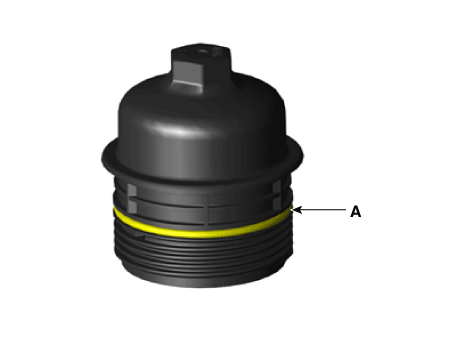
|
|
| (7) |
Finally tighten it again to the specified tightening torque.
|
Tightening torque :
31.4 - 38.2 N.m (3.2 - 3.9 kgf.m, 23.1 - 28.2 lb-ft)
|
|
|
| 4. |
Fill new engine oil.
| (1) |
Install the oil drain plug (A) with a new gasket.
|
Tightening torque :
34.3 - 44.1 N.m (3.5 - 4.5 kgf.m, 25.3 - 32.5 lb.ft)
|
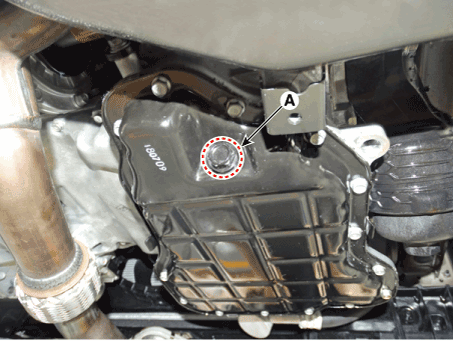
|
| (2) |
Install the drain under cover (A).
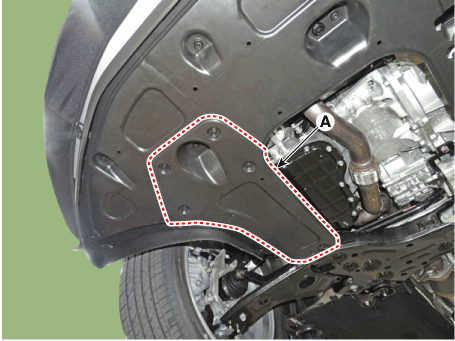
|
| (3) |
Fill with new engine oil while checking the oil level on the
dipstick.
|
Capacity
Total :
6.7 L (7.08 US qt, 5.89 lmp qt, 1.77 US.gal)
Oil pan :
6.4 L (6.76 US qt, 5.63 lmp qt, 1.69 US.gal)
Drain and refill including oil filter :
6.5 L (6.87 US qt, 5.72 lmp qt, 1.72 US.gal)
|
|
• |
Fill the crankcase to about half the capacity
and then fill the remainder after waiting.
|
|
• |
Do not fill oil over the 'F' mark. Frequently
check the level with the oil level gauge to
ensure no overfilling.
|
|
|
| (4) |
Install the oil filler cap and the oil dipstick.
|
|
| 5. |
Start the engine and check that no oil is leaking from the drain plug
or oil filter.
|
| 6. |
Recheck the engine oil level.
| •
|
When rechecking the engine oil level, be sure to warm
up the engine sufficiently. Otherwise, the measured
engine oil level may not reach the specification.
|
|
|
Engine Oil Level
| • |
Be sure that the vehicle is on level ground.
|
|
| 1. |
Warm up and stop the engine, and then wait for 5 minutes.
|
| 2. |
Turn the engine off and wait for a few minutes (about 5 minutes) for
the oil to return to the oil pan.
|
| 3. |
Pull the dipstick out, wipe and re-insert it fully.
|
| 4. |
Check that the oil level is between the "L" and "F" level marks on the
engine oil level gauge.
|
| 5. |
If the level is low, check for leakage and add oil up to the "F" level
mark.
| •
|
Use a funnel to help prevent spilling the oil on engine
components.
|
|
| •
|
Do not fill the engine with oil above the full level
mark.
|
|
|
Engine Oil Appearance
| 1. |
Check engine oil for white turbidity or heavy contamination.
|
| 2. |
If engine oil becomes turbid and white, it is highly probable that it
is contaminated with engine coolant.
Repair or replace damaged parts.
|
Selection Of Engine Oil
Specification
| – |
API SM, ILSAC GF-4 or above
|
Allowed SAE Viscosity
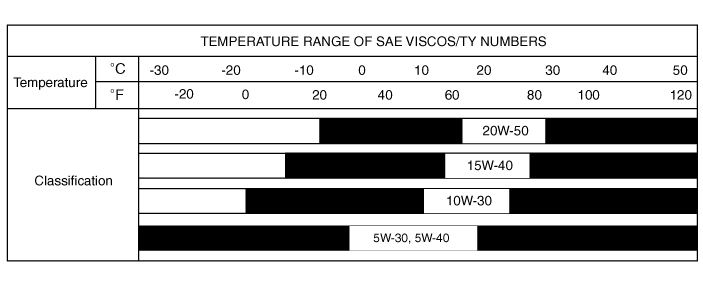
|
For best performance and maximum protection of all types of operation,
select only those lubricants which:
| 1) |
Satisfy the requirement of the ACEA classification.
|
| 2) |
Have proper SAE grade number for expected ambient temperature
range.
|
| 3) |
Have both an SAE grade number and ACEA service classification
on the container; otherwise, it should not be used.
|
|
Components and components location
Components
1. Oil fliter body
2. Gasket
Repair procedures
Removal
•
Be careful not to damage the parts located under the vehicle
(floor under cover, fuel filter, fuel tank and canister) when
raising the vehicle using the lift...
Other information:
System Standby
The Driver Attention Warning (DAW)
system enters the ready status and
displays the 'Standby' screen in the
following situations.
- The system is unable to collect
data to monitor the driver's driving
conditions.
- Driving speed remains under 40
mph (64 km/h) or over 110 mph
(180 km/h)...
Repair procedures
Inspection
Front and Rear Washer Motor
1.
With the washer motor connected to the reservoir tank, fill the reservoir
tank with water.
Before filling the reservoir tank with water, check the filter
for foreign material or contamination...
Categories
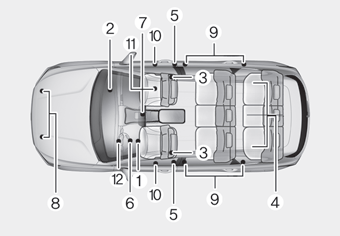
The SRS consists of the following
components:
1. Driver's front air bag module
2. Passenger's front air bag module
3. Side air bag modules
4. Curtain air bag modules
5. Retractor pre-tensioner
6. Air bag warning light
7. SRS control module (SRSCM)/
Rollover sensor
8. Front impact sensors
9. Side impact sensors
10.Side pressure sensors
11. Occupant classification system
12. Driver’s knee airbag module
read more

 Flow diagram
Flow diagram Oil Filter Body
Oil Filter Body


















